Okay, I96 mm is a known faceplate diameter, but there will be room to install a tweeter with a larger diameter faceplate e.g. 100 mm.
The KH-2110 loudspeaker has a high 90dB (1W@1m) sensitivity so we need to keep that in mind while searching for a tweeter replacement.
The tweeter crossover point is 3,500 Hz, apparently with a 12dB/octave slope. The 1" soft dome tweeter's DCR of 4.6 ohm indicates a 6 ohm nominal impedance.
Here are pictures I took of the measurements of the original tweeters and the enclosure cut out.I understand now - by mounting hole diameter, I meant the diameter of the enclosure cut out, not the diameter of the rebate.
It would appear to be a 96 mm tweeter.
I also took pictures of the new test tweeters, which as can be seen in the pictures are much smaller.
Attachments
-
 P_20220706_124811.jpg331.4 KB · Views: 47
P_20220706_124811.jpg331.4 KB · Views: 47 -
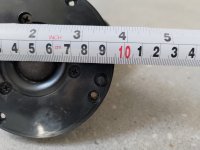 P_20220706_124816.jpg342.8 KB · Views: 52
P_20220706_124816.jpg342.8 KB · Views: 52 -
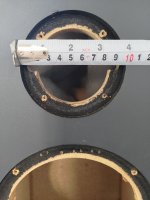 P_20220706_124636.jpg514.7 KB · Views: 44
P_20220706_124636.jpg514.7 KB · Views: 44 -
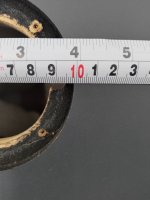 P_20220706_124641.jpg492.7 KB · Views: 43
P_20220706_124641.jpg492.7 KB · Views: 43 -
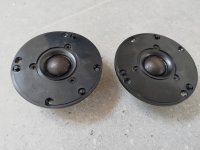 P_20220706_124711.jpg419.4 KB · Views: 55
P_20220706_124711.jpg419.4 KB · Views: 55 -
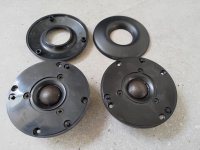 P_20220706_124736.jpg414.6 KB · Views: 60
P_20220706_124736.jpg414.6 KB · Views: 60 -
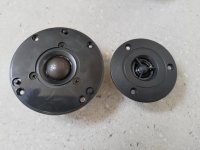 P_20220706_124916.jpg349.9 KB · Views: 45
P_20220706_124916.jpg349.9 KB · Views: 45 -
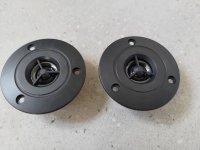 P_20220706_124900.jpg405 KB · Views: 43
P_20220706_124900.jpg405 KB · Views: 43 -
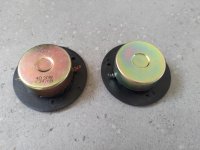 P_20220706_124907.jpg521.3 KB · Views: 50
P_20220706_124907.jpg521.3 KB · Views: 50
Sensitivity could be explained as how loud they go for a given amount of signal driving them. If you get a tweeter with too low a sensitivity it will be too quiet compared to the mids. This appears to be something you've called 'muddy', and you want to avoid this. You can't measure it with your meter, you can find it on the datasheet.
According to the datasheet the sensitivity comes in at 90db. I'm not sure if that means each driver is 90db, or if the overall speaker is?
That means then, when buying new replacements I should make sure the sensitivity is over 90db if I want to less muddy sound?
You can do the test without woofer playing, just remove the jumper bars from the terminals and connect the amplifier to the upper speaker binding posts.
View attachment 1069679
Yes, I tried this back in the beginning when I first got the speakers and noticed there was something off about the sound.
I tired both ways, just the highs connected, and also just the lows connected. The highs (tweeters) played at a much lower sound level than the lows (midranges and woofers). I think now with all the testing that's been done since it definitely appears to be an issue with both tweeters themselves, with one tweeter even being worse off than the other.
^^ Yes, but of course there is only one best level.. the real reason you want it to be at least a certain sensitivity is because you can always reduce it with resistance. The fact there is already resistance in the crossover also means you have room to make allowances in either direction.
Your best point of comparison might just be the temporary tweeters you bought.
Your best point of comparison might just be the temporary tweeters you bought.
yowza, you say you are located in Asia.
Do you have a preferred site from which it would be convenient for you to purchase new tweeters?
Yes, I am located in Asia, Taiwan to be specific. But I do travel to the US frequently so anything available there I would be able to get.
What's probably best is to give me your tweeter recommendations and I will then work out how to purchase them.
Prior to signing up and posting on this site I did come across the company below based in China that I could easily purchase their tweeters from locally here in Taiwan. Here's the site:
http://www.kasun.com.cn/product/c19/
And I came across this site too which you might already know about, they seem to sell to everywhere in the world.
https://www.digikey.com
And I also here that the brand Dayton Audio is very popular among people on this forum.
^^ Yes, but of course there is only one best level.. the real reason you want it to be at least a certain sensitivity is because you can always reduce it with resistance. The fact there is already resistance in the crossover also means you have room to make allowances in either direction.
Your best point of comparison might just be the temporary tweeters you bought.
The temporary tweeters I bought, aside from the impedance, I've got no clue of any other specs really. I simply bought them off of a local eBay style site, and they only cost me about $8 for both. The volume level they play at seems fine to me, but I can also tell they do sound a bit harsh, and I definitely want to replace them with something of better quality.
Hi! I'm having internet connection problems here at my holiday location.
I'll have a look at your supplier links and get back as soon as possible.
I'll have a look at your supplier links and get back as soon as possible.
The Peerless by Tymphany D27TG35-06 is a likely candidate:
4.8 ohm DCR; 6 ohm nominal; 91 db (@1W/1m); Fres 912 Hz
The only problem is its 104 mm faceplate diameter - how's your woodworking?
The UK price is £35 and Digi-Key have it listed as having 540 in stock.
https://cdn.shopify.com/s/files/1/0809/2387/files/D27TG35-06.pdf?842573435585941800
What do you think, AllenB?
4.8 ohm DCR; 6 ohm nominal; 91 db (@1W/1m); Fres 912 Hz
The only problem is its 104 mm faceplate diameter - how's your woodworking?
The UK price is £35 and Digi-Key have it listed as having 540 in stock.
https://cdn.shopify.com/s/files/1/0809/2387/files/D27TG35-06.pdf?842573435585941800
What do you think, AllenB?
The Peerless by Tymphany H26TG45-06 has a higher sensitivity of 95 dB (@1W/1m) and a DCR of 4.6 ohm.
The higher sensitivity would give us more headroom which could be padded down with series resistance if required.
Same 104 mm diameter faceplate. UK price £38.
https://cdn.shopify.com/s/files/1/0809/2387/files/H26TG45-06.pdf?17427181854799619148
The higher sensitivity would give us more headroom which could be padded down with series resistance if required.
Same 104 mm diameter faceplate. UK price £38.
https://cdn.shopify.com/s/files/1/0809/2387/files/H26TG45-06.pdf?17427181854799619148
I've reinstalled the crossovers and drivers, and have tested the sound.
With the original tweeters installed it sounds better than before, which I think can be attributed to the bad polyswitches. Since they have now been removed and jumped it seems to have done something. But there is still a kind of muffled sound, with one side sound worse than the other which depends on which tweeter is installed where. The overall muddiness isn't as pronounced.
With the new test tweeters installed it sounds better than before. Honestly from my untrained ear, it sounds pretty good. If the speakers sounded like this from day one of acquiring them I would've been content and not bothered reaching out to fix any sound issues. But, I do know that these tweeters aren't anything special, and with spending not much more I can have an even better sound.
I am open any suggestions for tweeters, not matter faceplate size, but I think if anything is 94mm that would be great. Once I have an idea of available choices I will then make a choice based on whatever seems right given the way the wind blows.
@Galu replying to your two post above. I don't have the proper tools to alter the faceplate diameter of the cabinet. I think it would require a wood router, which I don't have. But, I do have a Dremel multitool which could work, but would give less than impressive results. Because of this I'd rather not alter the cabinets. Any size I can make work. It can be any brand as well. Very much appreciated your help on this, especially given that you're on vacation!
With the original tweeters installed it sounds better than before, which I think can be attributed to the bad polyswitches. Since they have now been removed and jumped it seems to have done something. But there is still a kind of muffled sound, with one side sound worse than the other which depends on which tweeter is installed where. The overall muddiness isn't as pronounced.
With the new test tweeters installed it sounds better than before. Honestly from my untrained ear, it sounds pretty good. If the speakers sounded like this from day one of acquiring them I would've been content and not bothered reaching out to fix any sound issues. But, I do know that these tweeters aren't anything special, and with spending not much more I can have an even better sound.
I am open any suggestions for tweeters, not matter faceplate size, but I think if anything is 94mm that would be great. Once I have an idea of available choices I will then make a choice based on whatever seems right given the way the wind blows.
@Galu replying to your two post above. I don't have the proper tools to alter the faceplate diameter of the cabinet. I think it would require a wood router, which I don't have. But, I do have a Dremel multitool which could work, but would give less than impressive results. Because of this I'd rather not alter the cabinets. Any size I can make work. It can be any brand as well. Very much appreciated your help on this, especially given that you're on vacation!
Unfortunately, I have had no success in locating a 96 mm faceplate tweeter with the following properties: 90 dB plus sensitivity; ~4.6 ohm DCR (6 ohm nominal).
The above electrical properties are required to ensure a reasonable degree of compatibility with your existing crossover network.
Be sure to use these properties as the basis for your search. Digi-Key indicate both nominal impedance and sensitivity on their scroll-down tweeter list, so have a wade through that in case I missed something.
The above electrical properties are required to ensure a reasonable degree of compatibility with your existing crossover network.
Be sure to use these properties as the basis for your search. Digi-Key indicate both nominal impedance and sensitivity on their scroll-down tweeter list, so have a wade through that in case I missed something.
With the original tweeters installed it sounds better than before, which I think can be attributed to the bad polyswitches. Since they have now been removed and jumped it seems to have done something. But there is still a kind of muffled sound, with one side sound worse than the other which depends on which tweeter is installed where. The overall muddiness isn't as pronounced. With the new test tweeters installed it sounds better than before.
As I explained earlier, biwiring isolates the woofer section of the crossover from the midrange/tweeter section.
Could it be that the midrange drivers were also damaged, like the tweeters, by the overload - resulting in the muffled sound?
Brighter tweeters could mask the fact that the midrange drivers are not working properly.
It would be worth checking the operation of the midrange drivers.
As I explained earlier, biwiring isolates the woofer section of the crossover from the midrange/tweeter section.
Could it be that the midrange drivers were also damaged, like the tweeters, by the overload - resulting in the muffled sound?
Brighter tweeters could mask the fact that the midrange drivers are not working properly.
It would be worth checking the operation of the midrange drivers.
When I tested using biwire, bridges removed, the highs and lows separately, the woofers and midranges were on the same connection (lows), while the tweeters were alone on their own connection (highs). It might be unique to this speaker how the drivers are separated?
The woofers and midrange drivers sounded fine to me, the tweeters did not. This was way back in the beginning when I did this, before I signed up for this forum, when I first started listening to these speakers not too long after I got them. That was one clue to me that there was something wrong with the highs (crossovers and/or tweeters).
- Home
- Loudspeakers
- Multi-Way
- What to do? Wharfedale KH-2110 Issues